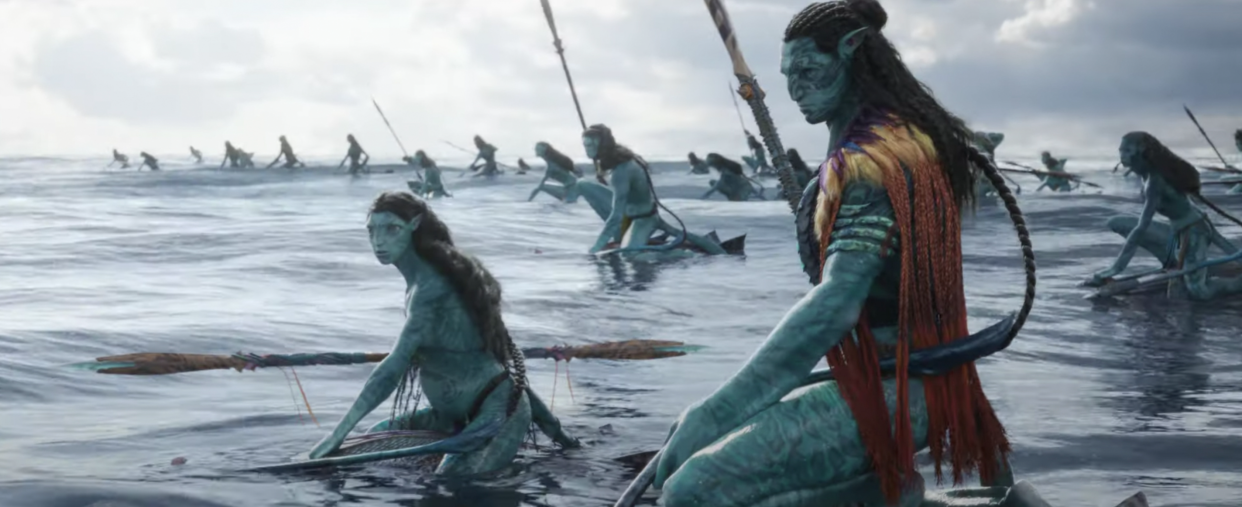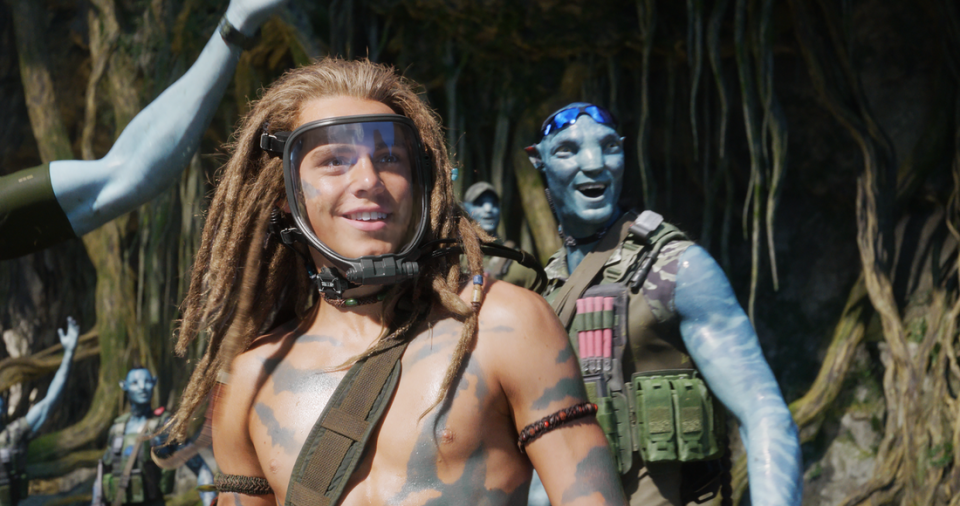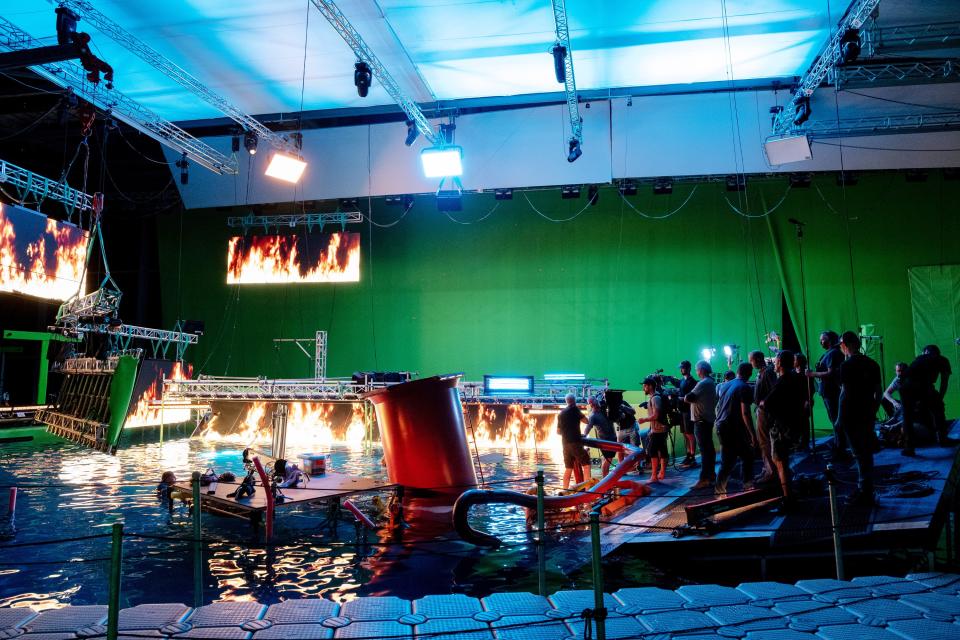‘Everything Is Based on Something Real’: Cinematographer Russell Carpenter on Shooting ‘Avatar: The Way of Water’

- Oops!Something went wrong.Please try again later.
- Oops!Something went wrong.Please try again later.
- Oops!Something went wrong.Please try again later.
The last time cinematographer Russell Carpenter partnered with director James Cameron, they both brought home Oscars for their work on “Titanic.” That was a famously arduous production, but on their latest collaboration, “Avatar: The Way of Water,” Carpenter quickly realized he would face another set of challenges: not only would he once again be shooting on and in the water, but he would have to learn a whole new language related to virtual lighting.
“That was totally new for me,” Carpenter told IndieWire. Before long, however, he realized that his basic job wasn’t that different from a conventional live-action film. “It’s the same as always in that you’re sculpting light. It’s a very different way of working, but the task is still the same.”
More from IndieWire
'Avatar 3' Will Introduce 'Evil Fire Na'vi,' Says James Cameron
'Avatar: The Way of Water' Continues Surge, Most Other New Titles Swoon as Holiday Nears End
In addition to “Titanic,” Carpenter had shot “True Lies” for Cameron, but did not photograph the original “Avatar.” (Mauro Fiore won an Academy Award for his cinematography on that film.) Carpenter’s initial involvement with the sequel began when Cameron asked him to shoot test footage of Spider, the primary human character who would need to be seamlessly integrated with the digital characters created by visual effects studio Wētā using real performances as reference material. “They put up a forest in the studio that was massive for a screen test,” Carpenter said. Cameron was happy with the way the footage looked and asked Carpenter to come on to the production a year before principal photography so that he could coordinate with visual effects on virtual photography while prepping for the live-action human elements like Spider.
Getting that character lit correctly was Carpenter’s primary concern, because he knew that if Spider didn’t match his surroundings or look as though he was responding to light in the same way as the digital characters the entire illusion would fall apart. “My mantra was, ‘Russell, you’ve got one job,'” Carpenter said. “To make Spider inhabit this virtual world, and to do that while the camera is moving like crazy. Your lighting has to be right on the money, because we all know what sunlight looks like, or what shade in a forest looks like, and if you deviate from that and get something wrong, like your contrast or have the light not quite coming from where it should be, you get into trouble pretty fast. The illusion that Spider is right there next to a Na’vi person starts to fall apart.”

Courtesy of 20th Century Studios
In fact, reality was a guiding principle for all of Cameron’s decisions on the film; although most of the imagery would ultimately be generated by Wētā computers, the director felt that anchoring the world in recognizable physics and behavior would create an uncanny, dreamlike response in the viewer. It’s why he shot his actors underwater rather than taking a “dry for wet” approach, why the actor’s facial expressions and movements needed to be captured as opposed to simply animated while the performers delivered their work in a recording studio, and why an expert cinematographer like Carpenter was needed to design the lighting scheme and color palette for the film. “Everything is based on something real,” Carpenter said. “If we have a fantastic looking animal in the movie, it replicates the locomotion of an animal on our planet so that it doesn’t seem like some sort of fantasy thing made in a computer.”
Carpenter spent the year of virtual lighting feeding Cameron information and figuring out creative ways of realizing the shots the director had in mind while other departments were working on the same problems. “It was basically one big anthill, and everybody’s trying to touch their antennae together to get the latest information,” Carpenter said. “That experience was so different for me from, here we are on a set, we’re going to shoot for a day and walk away with a really nice scene, or a really nice performance. On this, you’re guessing how things are going to look. All of this information — my lighting information, everything Jim did — it all streamed downhill toward the real world. A lot of the creativity then becomes about looking at all these diagrams and saying, ‘okay, what’s the proper piece of equipment to do this? How are we going to build the lighting system that’s going to do all the things we need to do?'”

Mark Fellman/Walt Disney Studios Motion Pictures/Courtesy Everett Collection
During the virtual lighting period, Carpenter observed that Cameron had a great deal of flexibility: “He had a bank of computers and he could just say, ‘I need this here. Make this Na’vi just a little bit shorter so it works for the framing. Yank this person over here.’ So my gaffer Len Levine and I said, ‘Okay, how do we give this experience to Jim when he’s on the set?'” Carpenter and Levine devised a system based on rock ‘n’ roll concert lighting that enabled them to light the jungle scenes without wasting time in between setups. “It eventually became kind of a Swiss Army knife that was able to morph from one situation to another without taking a horrendous amount of time,” Carpenter said. By putting moving lights on overhead trusses and lighting primarily from above, the cinematographer adapted to the demands of each individual scene and kept his lights from getting in the way of the ubiquitous blue screen.
When Carpenter did have to place light sources within the shots, his collaboration with Wētā visual effects supervisor Eric Sandon streamlined the process of eliminating them from the final image. “He was on the set every day, and I could run over to him and say, ‘We’ve taken heroic efforts, but we can’t keep this light source out of the shot,'” Carpenter said. “He would say, ‘okay, that’s not a problem.’ I would just have to ask him, ‘Are you getting what you need from me?’ Because I’m not going to be the person at a computer two years after I leave.”
Although there was a learning curve given the groundbreaking technology on the film, in the end Carpenter found it liberating compared to conventional filmmaking, because there was nothing obstructing the relationship between the actors and the camera. “Jim operates a lot of handheld. He loves to be close to the actors and move with them, and he basically can point the camera anywhere with this system. It’s such a different culture, because here’s our set but scattered around the stage are all these little compartments with 12 computers. That I wasn’t used to, and I wasn’t used to this elaborate ritual that you go through at the beginning of the day where you have to fuse what Jim’s camera did on the capture volume with the live-action camera. That takes a while, but once you do that you’re not locked in to what Jim visualized. It gave us a lot of freedom.”
Best of IndieWire
New Movies: Release Calendar for December 23, Plus Where to Watch the Latest Films
Sundance 2023 Movie Deals So Far: Paramount and Netflix Bite First
Sign up for Indiewire's Newsletter. For the latest news, follow us on Facebook, Twitter, and Instagram.

